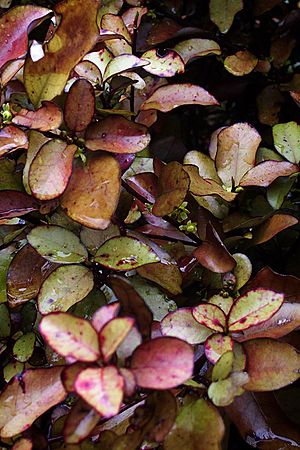Pseudowintera facts for kids
Quick facts for kids Pseudowintera |
|
|---|---|
 |
|
| Pseudowintera colorata | |
| Scientific classification |
|
| Kingdom: | Plantae |
| Clade: | Tracheophytes |
| Clade: | Angiosperms |
| Clade: | Magnoliids |
| Order: | Canellales |
| Family: | Winteraceae |
| Genus: | Pseudowintera Dandy |
| Species | |
|
|
Pseudowintera is a group of special plants found only in New Zealand. These plants are usually trees or shrubs that stay green all year round. They are known for their unique, peppery taste. People often call them horopito. They belong to a plant family called Winteraceae. These plants are related to ancient plants from the southern parts of the world.
Contents
Types of Horopito Plants
There are several types of Pseudowintera plants. Each one has its own special features and places where it grows.
- Pseudowintera axillaris, also called lowland horopito, is a small tree or shrub. It can grow up to eight meters tall. You can find it in forests that are not too high up, mainly in the South Island of New Zealand.
- Pseudowintera colorata, or mountain horopito, is a popular type. It is often called pepperwood because its leaves taste very spicy. This plant is a shrub or small tree, usually 1 to 2.5 meters tall. Its leaves are yellow and green with red spots. New leaves in spring are bright red. This horopito grows all over New Zealand, from low forests to higher mountain areas. Because it has many uses, when people say "horopito," they usually mean this type.
- Pseudowintera traversii, known as Travers horopito, is a small, bushy shrub. It grows up to one meter tall. This type is only found in a small area in the northwest of the South Island. It grows near towns like Collingwood and Westport.
Growing Horopito Plants
Horopito plants can grow naturally in areas where land has been cleared. You might also see them in people's gardens as pretty plants. In recent years, some people have started growing horopito for business.
Health Benefits of Horopito
Horopito contains a special substance called polygodial. This substance has many helpful properties. It can help fight against fungi and tiny germs. It may also help reduce swelling and act as a natural bug repellent. Scientists have found that polygodial is very good at stopping a common fungus called Candida albicans.
Traditional Uses of Horopito
Long ago, the Māori in New Zealand used horopito for many health reasons. They used it to treat skin problems caused by fungi. They also used it for stomach aches, diarrhea, and to help with pain. Early European settlers in New Zealand also learned to use horopito for its helpful properties.
Cooking with Horopito
Horopito leaves are used in many ways in cooking. Today, horopito is becoming a popular spice in modern New Zealand food. The leaves are usually dried and then ground into a powder. This powder can be used just like black pepper. You can sprinkle it on meats, mix it with oils, or use it to make sauces. It can also be added to vinegars, biscuits, and even ice-cream for a unique taste!
See also
 In Spanish: Pseudowintera para niños
In Spanish: Pseudowintera para niños

